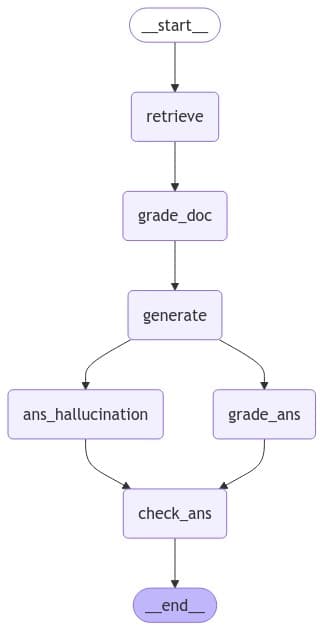After doing sequential graph execution in LangGraph, I wanted to explore the conditional and parallel execution graph flow, so I came up with a contrived example, where I have expanded a simple RAG use case.
What does the repo cover
This repo has examples of RAG with Human-in-loop, where the execution stops to take in the user input and than proceeds as per the user input. The repo has two flows:
- Conditional RAG + Human In Loop
- Parallel RAG Flow
Conditional RAG + Human In Loop
-
In this flow we have expanded the RAG flow to account for user input.
-
The flow has following steps:
- Flow starts with the user question.
- Than the flow goes to Retrieval step, where we try to retrieve relevant documents as per user question.
- Next we Grade the retrieved docs for relevance.
- If no doc is relevant, we break to take Human Input, asking the user if they want to stop execution or re retrieve the docs one more time.
- If the User says No, we stop the execution.
- If they say Yes, we go to the Retrieval step again. But we also increment the retry counter so that we don't keep re trying.
- So if the next retry also does not get right docs we just skip the Human Loop and end the flow.
- If the relevant documents were found, we skip the Human Intervention and go to the Generate answer phase.
- After the Generate step we run it through a conditional edge that checks the answer for Hallucination, and based on the result we either go to End or Answer Grader phase.
- The Answer Grader phase just validates the answer to see if it answers the user question.
- If the answer is valid it returns it else it returns a Sorry response.
-
Here is the flow diagram auto generated via LangGraph and Mermaid

-
Here is general Graph flow in short, details can be found in workflow.py
# All the Nodes we need workflow = StateGraph(GraphState) workflow.add_node(RETRIEVE, retrieve) workflow.add_node(GENERATE, generate) workflow.add_node(GRADE_DOC, grade_documents) workflow.add_node(GRADE_ANS, grade_generation) workflow.add_node(OUT_SCOPE_ANS, default_ans) workflow.add_node(HUMAN_FEEDBACK_AFTER_DOC_GRADE, human_feedback_after_doc_grade) workflow.add_node(MAX_ITERATION_RESPONSE, max_iteration_response) # Entry point of graph workflow.set_entry_point(RETRIEVE) # All the edges we need b/w nodes workflow.add_edge(RETRIEVE, GRADE_DOC) workflow.add_edge(MAX_ITERATION_RESPONSE, OUT_SCOPE_ANS) workflow.add_edge(GRADE_ANS, END) workflow.add_edge(OUT_SCOPE_ANS, END) # All the conditional edges we need b/w nodes workflow.add_conditional_edges( GRADE_DOC, should_ask_for_human_input, { HUMAN_FEEDBACK_AFTER_DOC_GRADE: HUMAN_FEEDBACK_AFTER_DOC_GRADE, GENERATE: GENERATE, MAX_ITERATION_RESPONSE: MAX_ITERATION_RESPONSE }, ) # all nodes where the graph can divert to intermediates = [OUT_SCOPE_ANS, RETRIEVE] workflow.add_conditional_edges( HUMAN_FEEDBACK_AFTER_DOC_GRADE, route_to_retrieveagain_or_end, intermediates ) # This is either or flow workflow.add_conditional_edges( GENERATE, grade_generation_for_hallucination, { 'not_hallucinated': GRADE_ANS, 'hallucinated': OUT_SCOPE_ANS } ) memory = MemorySaver() # we tell the graph to stop at this step graph_sequence = workflow.compile(checkpointer=memory, interrupt_before=[HUMAN_FEEDBACK_AFTER_DOC_GRADE, MAX_ITERATION_RESPONSE]) graph_sequence.get_graph().draw_mermaid_png(output_file_path='./graph-human-in-loop.png')
Parallel RAG Flow
-
In this flow we have simplified a bit and removed the Human factor for simplicity.
-
The flow runs the Answer Grader and Hallucination check in parallel.
-
The flow has following steps:
- Flow starts with the user question.
- Than the flow goes to Retrieval step, where we try to retrieve relevant documents as per user question.
- Next we go to the Generate step.
- After this we run the Answer Grader and Hallucination check steps in parallel.
- They both end up going to the Check Ans step. The beauty is the Check Ans step does not execute until both the parallel branches execution is finished.
-
Here is the flow diagram auto generated via LangGraph and Mermaid

-
Here is general Graph flow in short, details can be found in workflow_parallel.py
workflow = StateGraph(GraphState) # All nodes workflow.add_node(RETRIEVE, retrieve) workflow.add_node(GRADE_DOC, grade_documents) workflow.add_node(GENERATE, generate) workflow.add_node(GRADE_ANS, grade_generation) workflow.add_node(GRADE_ANS_HALLUCINATION, grade_ans_for_hallucination) workflow.add_node(CHECK_ANS, check_ans) # Entry point workflow.set_entry_point(RETRIEVE) # connection for the nodes workflow.add_edge(RETRIEVE, GRADE_DOC) workflow.add_edge(GRADE_DOC, GENERATE) workflow.add_edge(CHECK_ANS, END) # This is the Parallel flow, where we say a node fans out into 2 nodes workflow.add_edge(GENERATE, GRADE_ANS) workflow.add_edge(GENERATE, GRADE_ANS_HALLUCINATION) # this is the 2 nodes fanning in into a single node workflow.add_edge(GRADE_ANS, CHECK_ANS) workflow.add_edge(GRADE_ANS_HALLUCINATION, CHECK_ANS) memory = MemorySaver() # we tell the graph to stop at this step graph_parallel = workflow.compile(checkpointer=memory) graph_parallel.get_graph().draw_mermaid_png(output_file_path='./graph-parallel.png')
Local Development
- The repo has following folders:
- agent - This folder is a sub package and contains the code for:
- Chains - All the LLM chains are defined in this file.
- Graph - The Graph state is defined here.
- nodes - All the graph nodes are defined in this file.
- workflow - This has the workflow for the Conditional RAg with Human in loop.
- workflow_parallel - This has the workflow defined for parallel execution.
- doc_ingestion - This package contains the code for parsing the PDF and converting it into embeddings and creating a vector retrieval from it.
- prompts - This package has all the prompts needed to build the chain.
- agent - This folder is a sub package and contains the code for:
- The root level
main.pyfile is the entry point. This file imports the needed workflow and executes it. - For installing the dependencies there is a
requirement.txtfile, we can just run the following commandpip install -r requirements.txt.